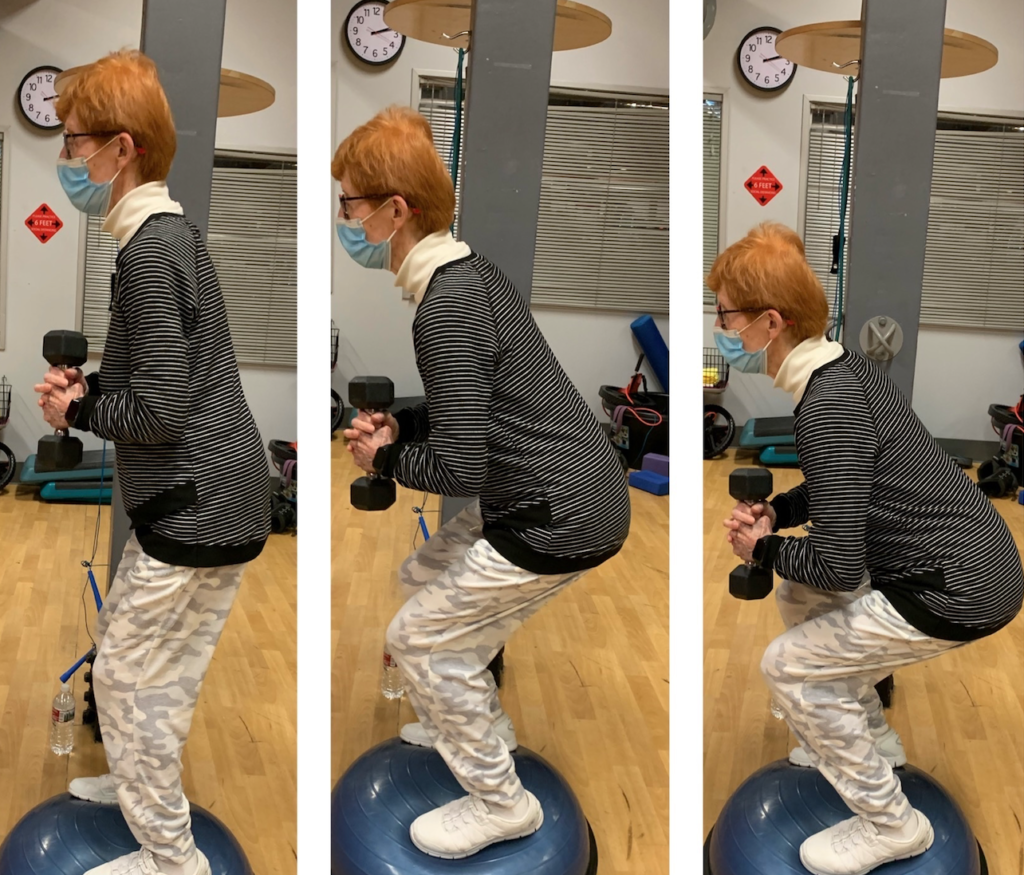
Balance training is helpful for people at any age. For elders, it is essential. Preventive training can help older people build muscle and proprioception, thereby reducing falls and injuries. It will also greatly increase quality of life, vitality, and confidence in activities of daily living.
The first two articles in this Building Balance series offered exercises for building core strength, and multiplanar exercises for the shoulders, low back, and gluteal muscles.
This third and final installment in the series focuses on balance exercises for the hips, legs, and feet, and then brings it all together with a few case examples from my own practice.
In working with clients, I realized how many people have a need for balance training. In working with a 75-year-old client, I developed a routine beginning with standing floor exercises that can then be translated onto a Bosu balance trainer or similar device.
The Bosu balance trainer is, basically, half of an inflatable exercise ball mounted to a rigid flat-bottomed frame. It creates a firm but supple dome with just the right amounts of support and “give.” Working with a Bosu is a fun way to build incredible amounts of core and stabilizer muscle strength.
If you think it’s not possible for elders to exercise safely using a Bosu, I can tell you that this is simply not true. Assuming they are not very frail, they’ve got reasonable range of motion, and a safe environment in which to practice, older people can really benefit from this approach. But it does require a little bit of extra attention to safety.
Be sure to assess an individual’s overall level of fitness and readiness for balance training. When beginning with a new client, I will usually stand quite close, so one side is next to a support (such as a wall) and I am protecting the other side. Patients can train safely at home if a family member is willing to be nearby.
Whether starting on the floor or on the balance trainer, it is prudent to work next to a wall or a sturdy piece of furniture for support. It is also important to keep the space clear around the client in case she needs to step off the balance trainer quickly
Working with a balance trainer is an enjoyable way to continue to challenge all muscles from foot to hip as well as the deep core musculature.
Whenever possible, it is helpful to have a large mirror nearby. This helps patients build neural pathways from the brain to muscles. Seeing what their bodies look like while doing things like hip hinges will help them visualize what they are sensing.
Before getting into any other exercises, though, it is important to begin with both feet solidly and squarely on the ground.
Standing on Four Corners
One tip that I find is very helpful for patients is to have them sense the four “corners” of each foot. The big toe, little toe, and each side of the heel represent a corner. Once a patient is tuned into that sensation, shift weight between those four corners. This helps build strength, and also confidence as the patient learns to “go with the flow” of ankle movement, rather than fighting to keep the ankles rigid and thwarting natural movement.
Before beginning the floor balance exercises, I like to have patients do a warm-up sequence that includes the glute bridges, hip hinges, and bodyweight squats which are described in depth in the previous articles. These exercises are excellent preparation for the more challenging balance exercises.
My experience has shown me that change is possible at any age. Elderly patients’ bodies and minds respond quickly to these exercises, especially when they are fun and enjoyable.
After warming up, the patient can progress to the following balance exercises:
One Leg Stands: This begins in an athletic stance with shoulders down and back, chest up, core braced, knees soft, and the weight shifted to heels. The pelvis should be in a neutral alignment, neither tilted forward nor arched backward. Likewise, the head and neck are in a neutral alignment, not pitched forward or tilted back. The ears should be right over the shoulders.
From this neutral stance, shift weight to the left leg and lift right foot off the floor for 30 seconds. Then repeat the movement on the other side, shifting the weight to the right leg and lifting the left foot. Perform two sets at 30 seconds. Increase the raised leg time as tolerated. Closing the eyes will add an extra challenge!
One Leg Hip Hinge: Think of this as a marriage of the hip hinge and the one leg stand. There is an incredible amount of core and glute/hip activation in this exercise.
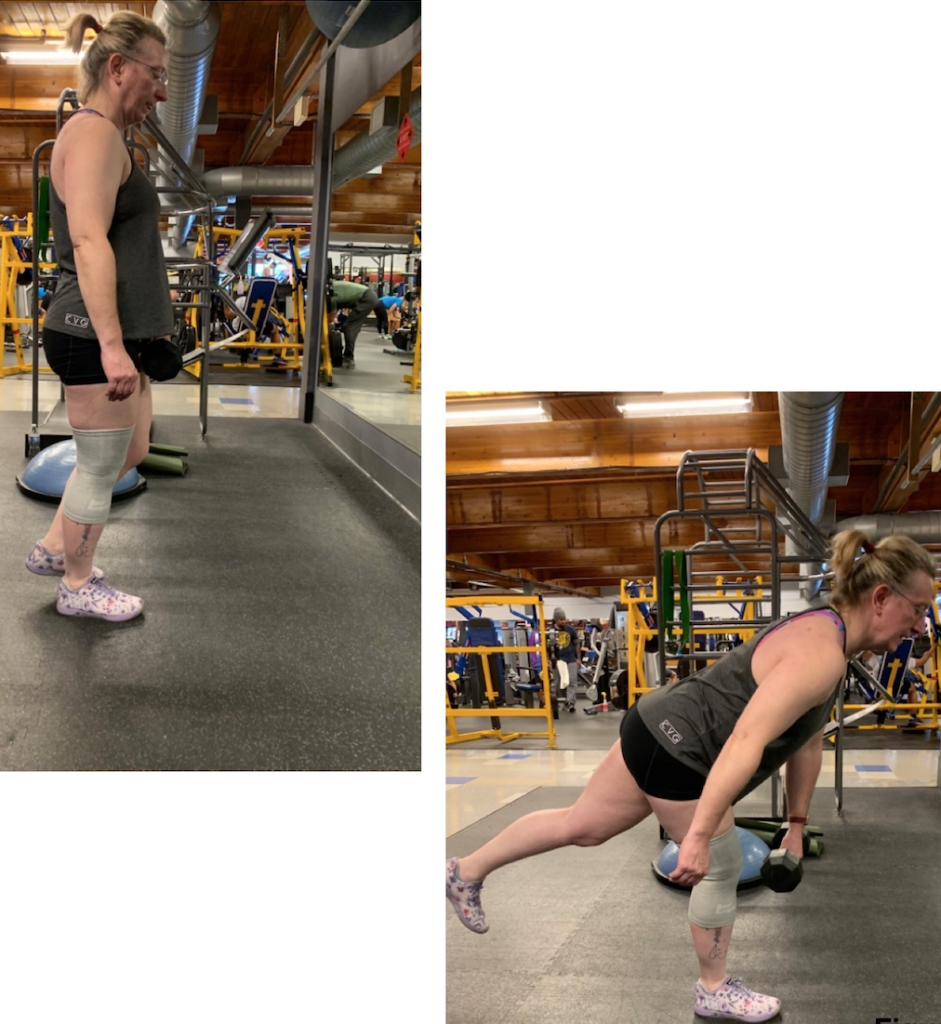
Begin in athletic stance on one leg. Keeping spine straight and shoulders back, hinge the hip back until there is a stretch in the hamstring. Then, pushing through the heel to activate hamstrings and gluteals, come back to a standing position. Repeat with other leg. As in all of these exercises, don’t try to force the movement beyond a comfortable and safe range of motion. Perform 2-3 sets of 10 repetitions.
Beginners often feel more secure practicing this near a wall, so they can reach and brace themselves if need be. This enables them to attain a wider range of motion in the hinge and leg extension.
Once someone has mastered the basic form of this exercise, s/he can increase the challenge by adding a weight such as a dumbbell or kettlebell.
Ice Skaters: This is a very challenging movement. Again, it’s helpful for beginners to work near a wall for support.
Like the previous exercise, this one also begins in athletic stance, but with weight shifted to the left leg. Have the patient raise the right leg forward as high as possible, within the attainable range of motion. Beginners may simply hover the foot above the floor. Cue the patient to draw a half circle on the floor by slowly bringing right leg behind them, while the left leg goes into a hip hinge.
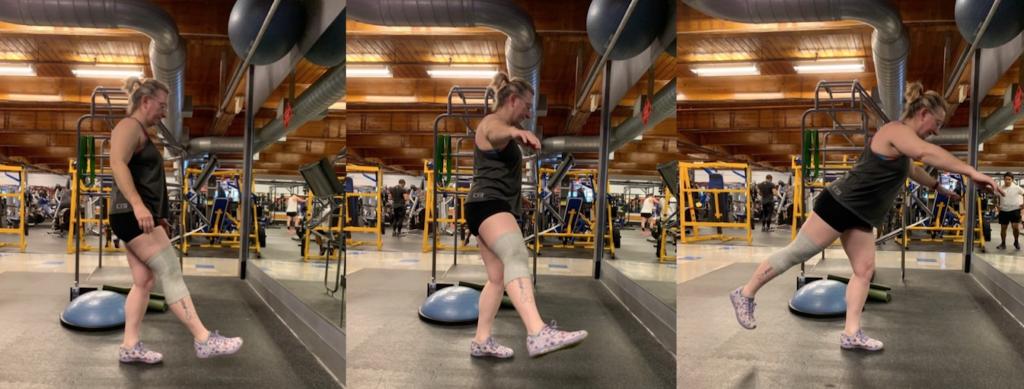
With the right leg extended behind (to the greatest extent possible), and the left in a hip hinge, have the patient extend the arms forward. Then slowly move the right leg back to front, coming out of hip hinge, and back into standing position. Repeat this 5-10 times on each leg for two sets.
Exercises on the Balance Trainer
Once a patient feels confident performing the floor balance exercises, then the real fun begins!
Working with a balance trainer is an enjoyable way to continue to challenge all muscles from foot to hip as well as the deep core musculature. For patients new to these devices, it is prudent to practice near some kind of stability such as a wall or a sturdy, stable chair.
The Bosu is marked with rings to help patients visualize where to stand so that the feet are evenly spaced. Generally, for these exercises, the third ring from the “bull’s eye” in the middle is a good place to start.
Weight Shifts & Toe/Heel Digs: These are really good warm-up exercises for beginning a session on the Bosu. Begin by standing on the dome in an athletic stance. Slowly shift weight from left foot to right foot 10 times. Then, still in athletic stance and with control, dig the toes into balance trainer, then dig in the heels. Repeat back and forth 10 times.
These simple shifts will give patients confidence in knowing the boundaries of their bodies on the balance trainer, while simultaneously warming up the muscles in the foot, ankle, and leg.
Hip Hinges: These are just like hip hinges on the floor, but here the patient is standing on the Bosu. Begin in athletic stance with weight shifted to the heels. Keep the knees soft, but not bent into a squat, and sit the hips back. Then, push through the heels to use hamstrings and gluteals to come back to stand, squeezing the gluteals at the top.

One Leg Stand: Place left foot in the middle of the bull’s eye and step onto trainer. Let the right leg hang to the side. Gently tapping right foot on the ball will help regain balance. Stand in this one-legged athletic stance for 30 seconds. Repeat two times on each leg. This exercise is particularly good for highlighting any discrepancies in balance and strength between the two sides of the body.
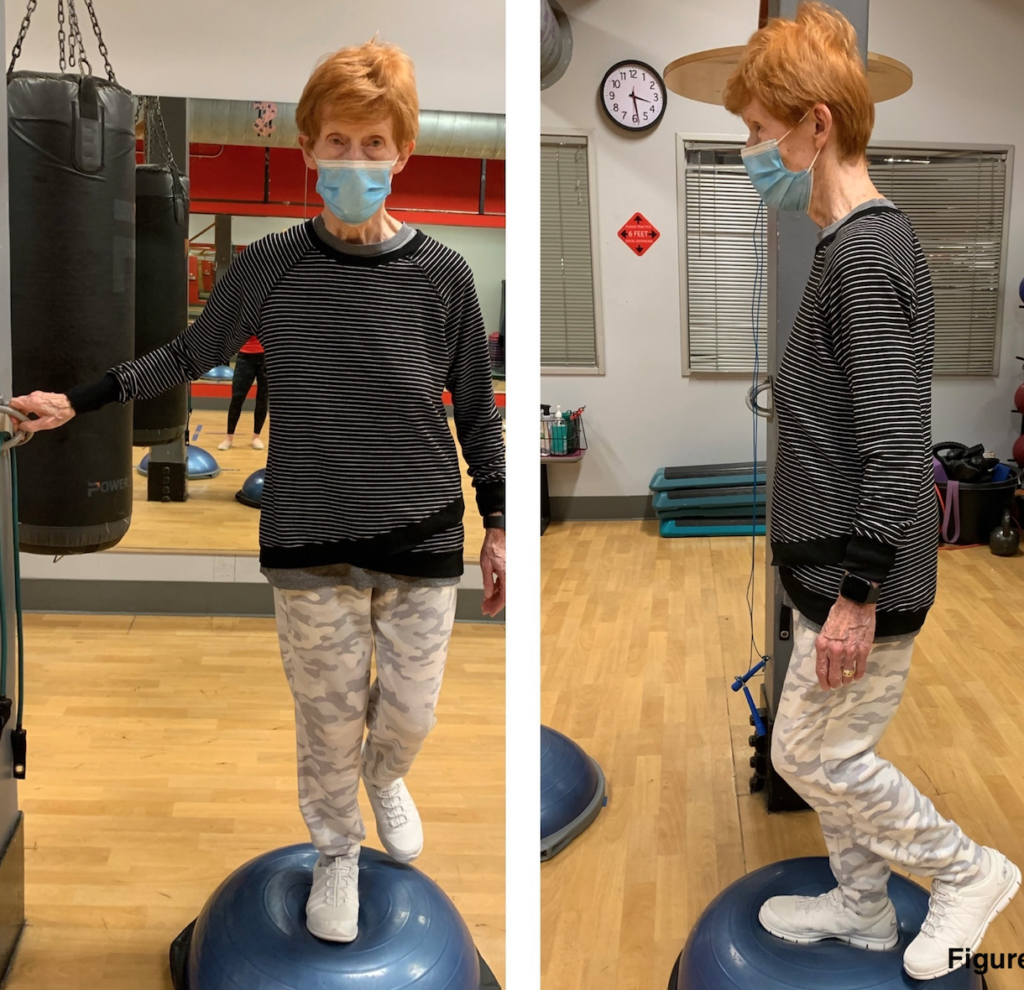
Squats/Weighted Squats: Stand in athletic stance on the trainer. Sit the hips back into a hinge, then bend the knees until thighs are parallel to the floor and the knees are at a 90o angle. Push through the heels to come to standing, squeezing the gluteals at the top. Perform 1-2 sets of 10 repetitions. Once a patient becomes comfortable and confident doing these squats, s/he can add a front weight such as a dumbbell or kettlebell to increase the challenge.
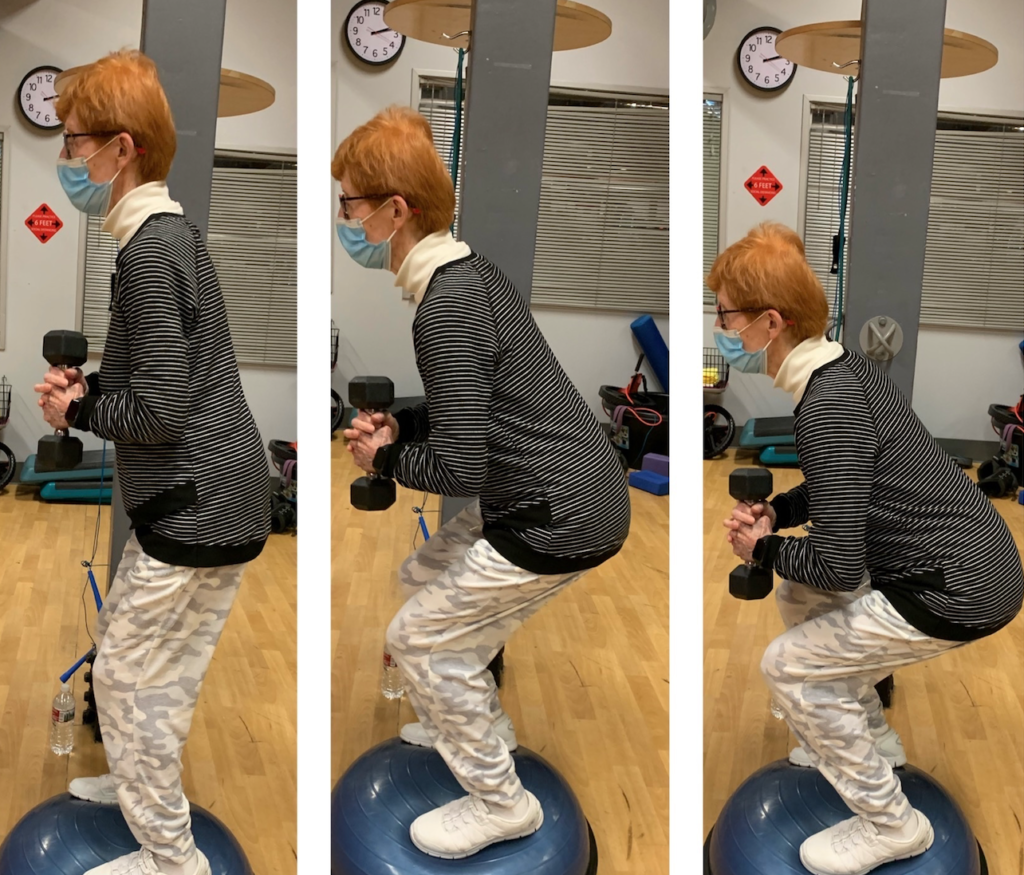
One Leg Hip Hinges: This is a very advanced movement that requires a lot of concentration. Wait until a patient is confident in all the other movements before introducing this one.
Perform a one-legged stand on the balance trainer. Sit hips back into a hinge, push through the heel to come to standing. Repeat 10 times on each leg, adding weight and/or repetitions to increase the challenge.
I’ve seen patients of all ages and occupations work with these exercises to build confidence and strength that radiates into all aspects of their everyday lives.
To advance any of these exercises, turn the balance trainer upside down so that the dome contacts the floor, and the patient is standing on the flat underside. This greatly increases the challenge because, with the supple hemispheric side on the ground, the trainer device is less stable.
When exercising with a balance trainer, work slowly and carefully, and always and be aware of the surroundings. For optimal progress, I advise performing these exercises 2-3 times a week, but patients will certainly see results with as few as one session per week. Consistency is key.
I’ve seen patients of all ages and occupations work with these exercises to build confidence and strength that radiates into all aspects of their everyday lives. Here are a few examples from among my clients:
- Val S., a 75-year-old mental health care worker in Anchorage, AK, has seen significant improvement in her balance. We spend 15-30 minutes on balance exercises and couple this with weight training to retain muscle and bone mass and increase her overall strength. Her balance and stamina have improved, and she often remarks that our sessions are the highlight of her week, since we bring fun and energy to our time together.
- Ken and Bobbi O., a married couple in their early 50’s, laud balance training as it has helped them in their daily life running a ranch as well as other businesses. They wrangle goats, horses, and hay bales weighing hundreds of pounds. No small feat! Practicing these balance exercises in addition to our weight training sessions has skyrocketed their energy levels and strength, while keeping their low backs healthy and pain free.
- John B., a 73-year-old engineer who is currently training for a bodybuilding show, greatly enjoys training with a Bosu ball. By learning how to properly brace his core and activate his gluteals for optimal strength, he keeps his knees and low back healthy and pain-free despite his intense workouts.
- Monica E., is a 23-year-old union laborer whom I trained while working for a naturopath in Fairbanks, AK. Her low back pain completely disappeared after she started corrective exercise training. She saw such improvement she began teaching her coworkers and her partner so they too could perform their jobs more efficiently.
Some people—especially older people—may assume that exercises like the ones I’ve described are off limits to them, or that they’re “too old” or “too far gone” for any of this to make a difference.
My experience has shown me that change is possible at any age. Elderly patients’ bodies and minds respond quickly to these exercises, especially when they are fun and enjoyable.
Just keep in mind that people progress differently, and that progress is usually non-linear. Factors such as stress level, sleep quality, nutrition, and hydration will influence the outcome of an exercise program too. A little bit of attention to all of these factors will help immensely.
You’re never too old to work on improving balance and strength!
END
Stacy Collier is an independent practice management and billing consultant based in Anchorage, AK. She is also a certified personal trainer with a special focus on Corrective Exercise Therapy, helping people living with low back, shoulder, hip, and knee pain. Stacy recently launched Attainable Fitness, LLC, her personal training and fitness coaching practice.







